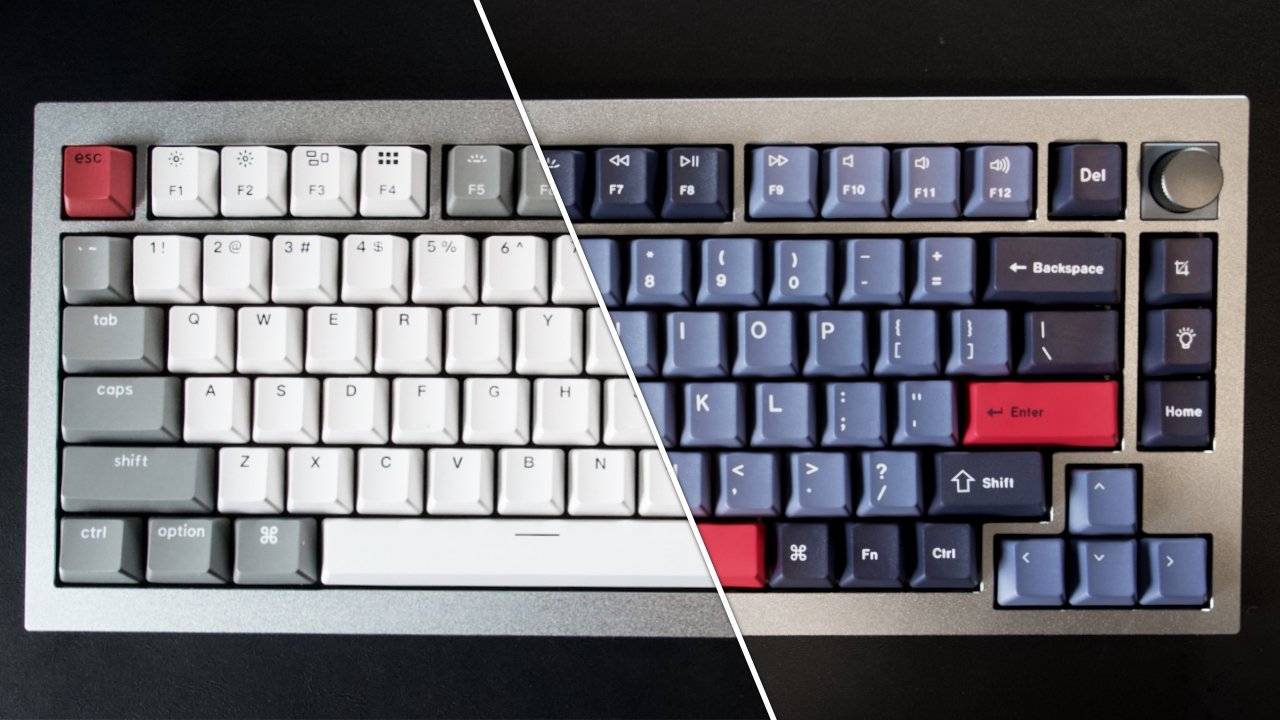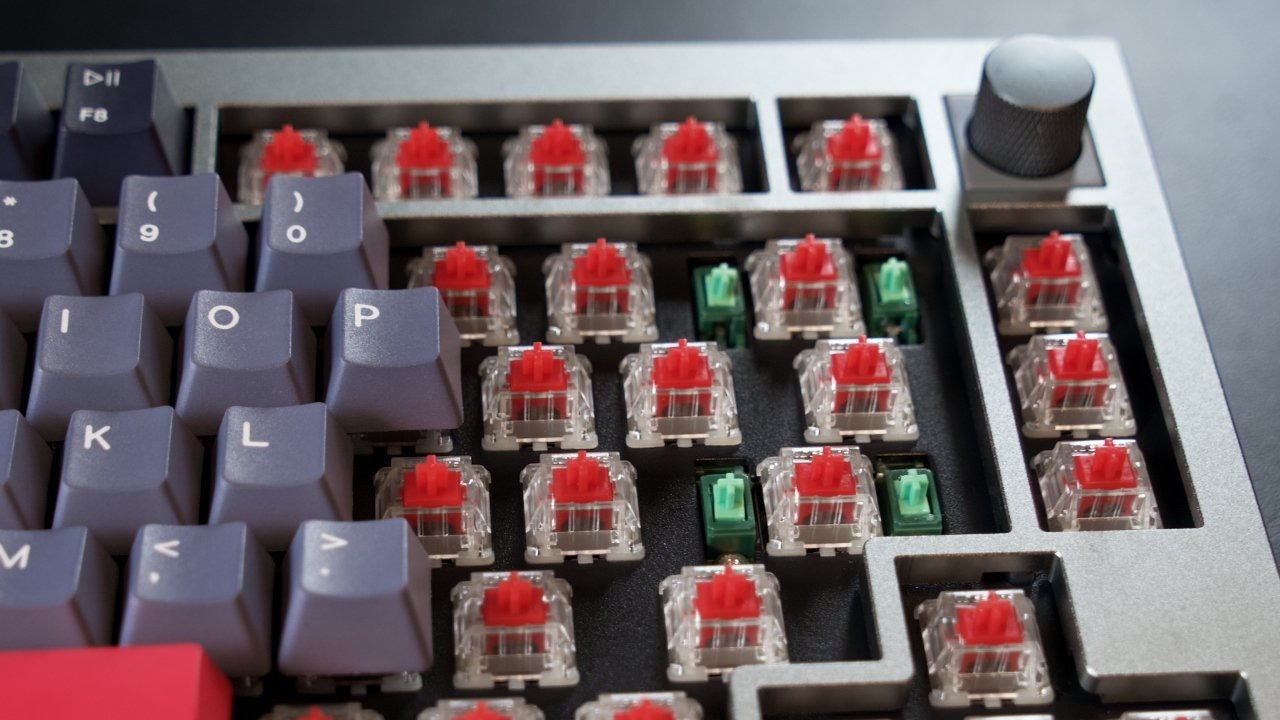The Keychron Q1 is a mechanical keyboard built for the enthusiast who wants to customize everything down to the switches while avoiding the mess of soldering keys.
Mechanical keyboards appeal to a particular niche, and the community forming around the topic can sometimes be daunting. Tune in to some popular keyboard live streams, and you'll see someone with a soldering iron replacing switches in their custom keyboard.
This can be enough to turn casual enthusiasts away.
However, Keychron has built the perfect keyboard to satisfy anyone who wishes to customize every aspect of their keyboard, without needing any advanced skills. The plug-and-play nature of the Keychron Q1 lets users go as deep into the customization rabbit hole as they like without having to buy extra tools or materials.
Beyond the headlining customization features, Keychron has created a sturdy keyboard with a modern aesthetic that calls back to classic Mac keyboards of yesteryear. We see the Keychron Q1 as a natural next step for someone who enjoys something like the Keychron K2 and wants something a little more custom.
Keychron Q1 Design
The aluminum case is available in carbon black, navy blue, and silver-gray. It is built around a stainless steel plate that adds weight and sturdiness to the structure.
The bottom case is thicker aluminum to increase the weight and reduce the "ping" noise when typing.
These parts add up to an undeniably heavy keyboard at about 4 pounds. It isn't meant to be moved around your home or used in the lap — it is a dedicated desktop keyboard.
To emphasize this, it is a wired-only keyboard too. Keychron includes a USB-C to C cable and USB-A adapter for maximum compatibility.
The knob version of the Q1 has a machined knob set in the top-right corner. It is color-matched to the aluminum case, but Keychron says the aluminum color isn't always an exact match since they are machined separately.
The Keychron Q1 uses south-facing RGB LEDs so that the light is distributed evenly around the keys on the keyboard.
Keychron ships the Q1 with opaque double-shot ABS cherry-style keys, not transparent ones. The final effect is light that faces the typist that doesn't shine directly into their eyes.
The RGB pattern, brightness, and color are fully customizable using specific key combinations. Hold the "Fn" key and tap "Q" or "A" to cycle between different patterns that strobe or rotate. "W" and "S" adjust brightness, "E" and "D" adjust color, and "R" and "F" adjust saturation when used with the "Fn" key.
Customization
Everything beyond the aluminum frame is user-customizable. Anyone who already owns mechanical keyboards or other Keychron models may have already tried buying custom keycaps to customize how the keyboard looks, and that function is here too. However, the Keychron Q1 takes it a few steps further.
Look past the aesthetic layer of keycaps, and you'll see a layer of switches. These switches come pre-installed and are chosen by the buyer at checkout, but users can swap these switches out with different types to change various aspects of their typing experience.
Typically, switches need to be soldered into the keyboard to function, but the Keychron Q1 is a hot-swappable keyboard. This means switches can be traded on the fly without the need to solder or program.
Hot-swapping switches isn't a new concept, but Keychron takes it a step further by making every key on the keyboard re-programmable using an app called Via. More on the app and programming keys later.
Keychron sent us a keyboard with Gateron G Pro Blue switches and a white/gray keycap set already installed. This configuration would blend in with most desktop setups, and the blue keycaps were clicky with a strong actuation force.
We prefer red switches, so we traded out the blue switches with red switches.
The process for changing out every switch is a tedious one. First, you remove every keycap using the included keycap remover tool. Then you remove every switch using custom tweezers that depress locking mechanisms under each switch.
After removing every blue switch, I placed red switches carefully in every slot. The pins have to align with the slot they are going into and cannot be forced in, as the key won't work if the pins are bent.
The result was essentially a completely different keyboard in the Q1 aluminum case. The Gateron G Pro Red switches have a low actuation force and make a much more muffled, quiet sound.
The custom keycap set with blue and red keycaps were also more suited to our preferences as well.
Via software
Keychron advertises the Via software for programming the Keychron Q1. We installed the software directly from Github and ran it with little issue after enabling it in System Preferences.
After changing all of the key switches out, we used Via to test the function of every key to verify no pins were bent. Only the left Command key was not functioning, but it was quickly replaced with a new switch.
As you can see from our images, the Page Up and Page Down keys were swapped for different keys. We decided to use a screenshot key and a lightbulb key instead, but functionally, these keys still acted as Page Up and Page Down at first.
Within the Via software, users can choose from any key function to replace a key or even program custom macros to occur when a key is pressed. Even the knob can be adjusted to perform different functions when pressed.
For simplicity, we chose to reprogram only our new keys. F13 was set to take a screenshot using Clean Shot X, and the lightbulb key turns off the keyboard backlight.
Should you buy the Keychron Q1?
We love the customization options available for the Keychron Q1 and will be experimenting with different keys and programming macros for functions for some time. The ability to try different switch types in the same keyboard with a simple swap is also quite a boon since we'd prefer never to handle solder again if at all possible.
Typing on the Keychron Q1 is just as great an experience as other Keychron keyboards we've reviewed. Keychron says the construction and padding are supposed to change specific aspects of how the keyboard feels, but we're not discerning enough to notice those differences.
This keyboard certainly isn't for everyone. This shouldn't be your first mechanical keyboard by any stretch. If you didn't like mechanical keyboards before, this keyboard won't change your mind.
The Keychron Q1 is bulky, heavy, and meant to be used at a desktop connected via a cable. There are no options for Bluetooth, so fast swapping between devices isn't possible.
However, Universal Control does open up the option of using it on multiple devices in a single session, which makes the lack of Bluetooth a non-issue.
Pros
- Hot swappable keys
- Changable key caps
- Integrated volume knob
- Fully programmable
- RGB ligthing well executed
Cons
- Heavy
- Wired only
- Complicated lighting controls
Rating: 4.5 out of 5
Where to buy
- Get the Keychron Q1 direct from Keychron for $189
- Gateron Switches from Amazon for $13.50
- PBT Keycaps for MX switches from Amazon for $19.99
 Wesley Hilliard
Wesley Hilliard













-m.jpg)






 Marko Zivkovic
Marko Zivkovic

 Malcolm Owen
Malcolm Owen

 Amber Neely
Amber Neely












2 Comments
I have the Q2 model and love it.
Never understood the enthusiasm for mechanical keyboards, but to each his own.